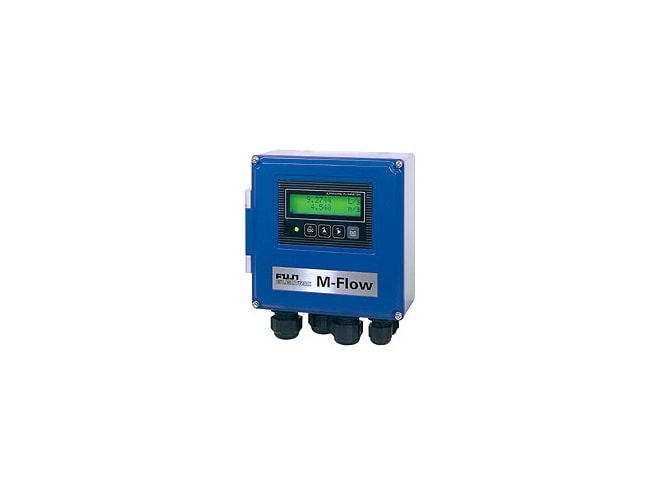Fuji Electric Time Delta M-Flow Ultrasonic Flow Meter
State-of-the-art, economical alternative to magnetic, vortex, and differential pressure transmitters.

Overview
Features
- Analog output, totalizer pulse, relay outputs all included as standard options
- Fast and Easy Installation with no need to connect to a laptop PC
- Compact and Lightweight
- Quick Response processing (200 ms) suits high-speed batch processing
- Instrument setup and display supported in English, Spanish, German and French
- Compensation system eliminates error from temperature and pressure fluctuations
Description
See accessories tab.
The Fuji Electric Time Delta M-Flow ultrasonic flow meter is a state-of-the-art, economical alternative to magnetic, vortex, and differential pressure transmitters. The Fuji Electric Time Delta M-Flow ultrasonic flow meter combines advanced microprocessing detection methods with a versatile design to provide accurate and obstruction-less flow measurement of any clean water application.
The Fuji Electric Time Delta M-Flow ultrasonic flow meter features high reliability and accuracy (up to 0.5%), and long-term maintenance-free operation.
Programming the Fuji Electric Time Delta M-Flow ultrasonic flow meter is simple via the front panel keypad; no PC is required for setup. Compact and lightweight, the Fuji Electric Time Delta M-Flow ultrasonic flow meter incorporates the latest LSI technology for compact and rugged design at less than 2 pounds.
In addition, the Fuji Electric Time Delta M-Flow ultrasonic flow meter features a high-resolution, 2-line, backlit display, and signal quality indication. The non-intrusive clamp-on sensors are quickly installed without interrupting process flows or incurring pressure loss. Fuji Electric Time Delta M-Flow ultrasonic flow meters have a proprietary temperature and pressure compensation system, which completely eliminates error created by process temperature and pressure fluctuations.
Transit Time Ultrasonic Flow Meters – Technology Explained
Transit Time ultrasonic flow meters are well-suited for relatively clean fluids with low to moderate aeration. These meters operate by comparing the time for an ultrasonic signal to travel with the flow (downstream) against the time for an ultrasonic signal to travel against the flow (upstream). The difference between these transit times is proportional to the flow, and the flow meter converts this information to flow rate and total. With this technology, the transducers are mounted on the outside of the pipe, providing tremendous advantages over more traditional and invasive flow measurement instruments such as magmeters, vortex meters, and turbine flow meters. These benefits include no system downtime for installation, no system contamination, no pressure drop, no moving parts, and no risk of leaks. This product is virtually maintenance free.
Documents
Need Help? Call a Flow engineer at 1-800-884-4967
We're open Mo-Th 8am to 5:30pm. Fr 8am to 5pm ET
















